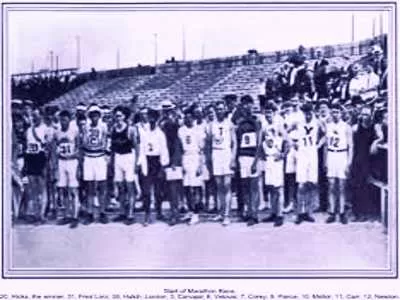The Wild and Wacky 1904 Olympic Marathon: A True Circus
While I may not be a sports enthusiast, I have a fascination for the bizarre, and few events in sporting history are as peculiar as the 1904 Olympic Marathon. Held in St. Louis, Missouri, the 1904 Olympics were less about athletic prowess and more about a chaotic spectacle that resembled a circus more than a serious sporting event.

The marathon, in particular, was riddled with mismanagement, strange occurrences, and unforgettable characters that make it a standout moment in Olympic history.
Chaotic Setting
The 1904 Olympics were part of the Louisiana Purchase Exposition, a world’s fair celebrating the centenary of the purchase. The Olympic events were overshadowed by the fair’s cultural presentations, and the organization of the games was so poor that it nearly led to the demise of the modern Olympics. Out of 36 registered runners, only 32 showed up for the marathon on August 30, 1904. The race began at 3 PM, under a sweltering sun with temperatures soaring to 90°F (32°C).
The marathon course was anything but ideal. Runners had to navigate sun-baked dirt trails and rocky paths, with only one watering station at the halfway point—twelve miles into the race. The support staff, including race officials and journalists, added to the chaos, creating clouds of dust and fumes from their automobiles and bicycles.
Race Begins
As the runners set off, the atmosphere was tense. After three hours and thirteen minutes, Fred Lorz crossed the finish line first, appearing surprisingly fresh. Just as he was about to receive his laurel wreath from President Theodore Roosevelt’s daughter, Alice, Lorz confessed that he had not completed the race as intended. After collapsing from heat exhaustion, he had hitched a ride in a support vehicle for part of the race. When the car broke down, he jogged the last few miles, pretending to be the victor. The Amateur Athletic Union (AAU) banned him for life, although this decision was later rescinded, and Lorz went on to win the 1905 Boston Marathon.
True Champion
Following Lorz, Thomas Hicks, an English-born runner representing the USA, staggered across the finish line in a time of 3:28:53. Hicks had struggled throughout the race, receiving a controversial mix of water-soaked sponges, strychnine (a dangerous stimulant), and brandy from his trainers. By the time he reached the stadium, he was delirious and had lost ten pounds. After being revived by doctors, he received his gold medal but never competed again.
Colorful Cast of Characters
The marathon featured a cast of characters that could only be described as extraordinary. Albert Corey, a French butcher who had crossed the picket line during a strike, finished second but was registered as an American due to paperwork issues. Arthur Newton claimed the bronze medal with a time of 3:47:33.
Then there was Félix Carvajal, a Cuban postman who had run the length of Cuba to afford his boat ticket to the USA. Arriving in St. Louis with little money, he lost what he had in a dice game. Dressed in heavy street clothes, he had to cut his trousers into makeshift shorts. Carvajal began the race with enthusiasm, even stopping to eat green apples from an orchard, which led to stomach cramps. Despite these setbacks, he finished fourth, embodying the spirit of the underdog.
Another notable participant was Len Taunyane, a Tswana tribesman brought to the fair as part of an exhibit. He faced a detour of over a mile to avoid a ferocious dog, yet he still managed to finish the race.
Race of Misfortune
The marathon was fraught with misfortune. William Garcia, the winner of the 1903 Boston Marathon, was found unconscious by the side of the road, suffering from severe dehydration and dust inhalation. He was taken to the hospital after being driven back to the stadium by a local couple.
The race also saw a support vehicle crash into a trench, injuring two officials. Out of the 32 starters, an astonishing 18 runners failed to finish, highlighting the grueling conditions they faced.
Other Olympic Oddities
While the marathon was a spectacle, the 1904 Olympics had its share of other bizarre moments. George Eyser, a gymnast with a wooden leg, won two golds, three silvers, and a bronze, showcasing incredible determination and skill. Frank Kugler made history by winning medals in three different sports: wrestling, weightlifting, and tug-of-war, a feat that seems almost too good to be true.
Conclusion: A Legacy of Absurdity
The 1904 Olympic Marathon stands as a testament to the unpredictable nature of sports and the human spirit. From the bizarre antics of Fred Lorz to the determination of Thomas Hicks and the colorful stories of runners like Félix Carvajal, this marathon was anything but ordinary.
As we reflect on this chaotic event, we are reminded that sometimes, the most memorable moments in sports are not about records or medals but about the stories that unfold along the way. The 1904 Olympic Marathon may have been a circus, but it was a circus that captured the imagination and left an indelible mark on Olympic history..